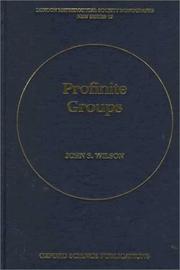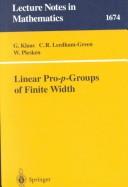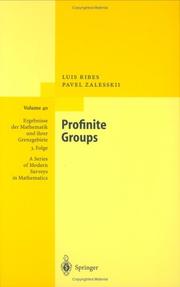| Listing 1 - 9 of 9 |
Sort by
|

ISBN: 9780198500827 0198500823 Year: 1998 Publisher: Londres Oxford university press
Abstract | Keywords | Export | Availability | Bookmark
 Loading...
Loading...Choose an application
- Reference Manager
- EndNote
- RefWorks (Direct export to RefWorks)
Book
ISBN: 9780521183017 9781107005297 1107005299 0521183014 9780511793837 9781139117593 1139117599 9781139128254 1139128256 9781139115421 1139115421 0511793839 1107221277 1139235079 1283298570 1139123343 9786613298577 1139113232 Year: 2011 Volume: 77 Publisher: Cambridge Cambridge University Press
Abstract | Keywords | Export | Availability | Bookmark
 Loading...
Loading...Choose an application
- Reference Manager
- EndNote
- RefWorks (Direct export to RefWorks)
In this book, three authors introduce readers to strong approximation methods, analytic pro-p groups and zeta functions of groups. Each chapter illustrates connections between infinite group theory, number theory and Lie theory. The first introduces the theory of compact p-adic Lie groups. The second explains how methods from linear algebraic groups can be utilised to study the finite images of linear groups. The final chapter provides an overview of zeta functions associated to groups and rings. Derived from an LMS/EPSRC Short Course for graduate students, this book provides a concise introduction to a very active research area and assumes less prior knowledge than existing monographs or original research articles. Accessible to beginning graduate students in group theory, it will also appeal to researchers interested in infinite group theory and its interface with Lie theory and number theory.
Profinite groups. --- Group theory. --- Group theory --- Profinite groups --- Groups, Theory of --- Substitutions (Mathematics) --- Algebra
Multi
ISSN: 00711136 ISBN: 9783642016424 9783642016431 9783642016417 9783642262654 Year: 2010 Volume: 40 Publisher: Berlin, Heidelberg Springer Berlin Heidelberg
Abstract | Keywords | Export | Availability | Bookmark
 Loading...
Loading...Choose an application
- Reference Manager
- EndNote
- RefWorks (Direct export to RefWorks)
The aim of this book is to serve both as an introduction to profinite groups and as a reference for specialists in some areas of the theory. The book is reasonably self-contained. Profinite groups are Galois groups. As such they are of interest in algebraic number theory. Much of recent research on abstract infinite groups is related to profinite groups because residually finite groups are naturally embedded in a profinite group. In addition to basic facts about general profinite groups, the book emphasizes free constructions (particularly free profinite groups and the structure of their subgroups). Homology and cohomology is described with a minimum of prerequisites. This second edition contains three new appendices dealing with a new characterization of free profinite groups, presentations of pro-p groups and a new conceptually simpler approach to the proof of some classical subgroup theorems. Throughout the text there are additions in the form of new results, improved proofs, typographical corrections, and an enlarged bibliography. The list of open questions has been updated; comments and references have been added about those previously open problems that have been solved after the first edition appeared.
Number theory --- Group theory --- Ordered algebraic structures --- Topological groups. Lie groups --- Topology --- topologie (wiskunde) --- wiskunde --- getallenleer --- topologie --- Profinite groups
Book
ISBN: 9780521747660 052174766X 9781139107082 9781139127417 1139127411 1139107089 9781139114585 1139114581 9781139116756 1139116754 9781283295796 1283295792 1107193400 9781107193406 9786613295798 6613295795 1139122495 9781139122498 1139112392 9781139112390 Year: 2009 Volume: 361 Publisher: Cambridge, UK New York
Abstract | Keywords | Export | Availability | Bookmark
 Loading...
Loading...Choose an application
- Reference Manager
- EndNote
- RefWorks (Direct export to RefWorks)
After a forty-year lull, the study of word-values in groups has sprung back into life with some spectacular new results in finite group theory. These are largely motivated by applications to profinite groups, including the solution of an old problem of Serre. This book presents a comprehensive account of the known results, both old and new. The more elementary methods are developed from scratch, leading to self-contained proofs and improvements of some classic results about infinite soluble groups. This is followed by a detailed introduction to more advanced topics in finite group theory, and a full account of the applications to profinite groups. The author presents proofs of some very recent results and discusses open questions for further research. This self-contained account is accessible to research students, but will interest all research workers in group theory.
Finite groups. --- Profinite groups. --- Solvable groups. --- Group theory. --- Groups, Theory of --- Substitutions (Mathematics) --- Algebra --- Soluble groups --- Group theory --- Groups, Finite --- Modules (Algebra)

ISBN: 3540636439 3540696237 9783540636434 Year: 1997 Volume: 1674 Publisher: Berlin Springer
Abstract | Keywords | Export | Availability | Bookmark
 Loading...
Loading...Choose an application
- Reference Manager
- EndNote
- RefWorks (Direct export to RefWorks)
The normal subgroup structure of maximal pro-p-subgroups of rational points of algebraic groups over the p-adics and their characteristic p analogues are investigated. These groups have finite width, i.e. the indices of the sucessive terms of the lower central series are bounded since they become periodic. The richness of the lattice of normal subgroups is studied by the notion of obliquity. All just infinite maximal groups with Lie algebras up to dimension 14 and most Chevalley groups and classical groups in characteristic 0 and p are covered. The methods use computers in small cases and are purely theoretical for the infinite series using root systems or orders with involutions.
Group theory --- Linear algebraic groups. --- Profinite groups. --- p-adic groups. --- Linear algebraic groups --- Profinite groups --- p-adic groups --- Mathematical Theory --- Mathematics --- Physical Sciences & Mathematics --- Groupes algébraïques linéaires --- Groupes p-adiques --- Groupes profinis --- Groups [p-adic ] --- Lineaire algebraïsche groepen --- Group theory. --- Group Theory and Generalizations. --- Groups, Theory of --- Substitutions (Mathematics) --- Algebra

ISBN: 3540669868 3642086322 3662040972 Year: 2000 Volume: 3. Folge, v. 40 Publisher: New York ; Berlin ; Heidelberg Springer
Abstract | Keywords | Export | Availability | Bookmark
 Loading...
Loading...Choose an application
- Reference Manager
- EndNote
- RefWorks (Direct export to RefWorks)
The aim of this book is to serve both as an introduction to profinite groups and as a reference for specialists in some areas of the theory. In neither of these two aspects have we tried to be encyclopedic. After some necessary background, we thoroughly develop the basic properties of profinite groups and introduce the main tools of the subject in algebra, topology and homol ogy. Later we concentrate on some topics that we present in detail, including recent developments in those areas. Interest in profinite groups arose first in the study of the Galois groups of infinite Galois extensions of fields. Indeed, profinite groups are precisely Galois groups and many of the applications of profinite groups are related to number theory. Galois groups carry with them a natural topology, the Krull topology. Under this topology they are Hausdorff compact and totally dis connected topological groups; these properties characterize profinite groups. Another important fact about profinite groups is that they are determined by their finite images under continuous homomorphisms: a profinite group is the inverse limit of its finite images. This explains the connection with abstract groups. If G is an infinite abstract group, one is interested in deducing prop erties of G from corresponding properties of its finite homomorphic images.
Groupes profinis --- Profinite groups --- Profinite groups. --- 512.54 --- Groups. Group theory --- 512.54 Groups. Group theory --- Group theory --- Group theory. --- Topological groups. --- Lie groups. --- Number theory. --- Topology. --- Group Theory and Generalizations. --- Topological Groups, Lie Groups. --- Number Theory. --- Analysis situs --- Position analysis --- Rubber-sheet geometry --- Geometry --- Polyhedra --- Set theory --- Algebras, Linear --- Number study --- Numbers, Theory of --- Algebra --- Groups, Lie --- Lie algebras --- Symmetric spaces --- Topological groups --- Groups, Topological --- Continuous groups --- Groups, Theory of --- Substitutions (Mathematics)
Book
ISBN: 364201643X 3642016413 3642262651 1282835394 3642016421 9786612835391 9783642016417 Year: 2010 Publisher: Berlin ; New York : Springer,
Abstract | Keywords | Export | Availability | Bookmark
 Loading...
Loading...Choose an application
- Reference Manager
- EndNote
- RefWorks (Direct export to RefWorks)
The aim of this book is to serve both as an introduction to profinite groups and as a reference for specialists in some areas of the theory. The book is reasonably self-contained. Profinite groups are Galois groups. As such they are of interest in algebraic number theory. Much of recent research on abstract infinite groups is related to profinite groups because residually finite groups are naturally embedded in a profinite group. In addition to basic facts about general profinite groups, the book emphasizes free constructions (particularly free profinite groups and the structure of their subgroups). Homology and cohomology is described with a minimum of prerequisites. This second edition contains three new appendices dealing with a new characterization of free profinite groups, presentations of pro-p groups and a new conceptually simpler approach to the proof of some classical subgroup theorems. Throughout the text there are additions in the form of new results, improved proofs, typographical corrections, and an enlarged bibliography. The list of open questions has been updated; comments and references have been added about those previously open problems that have been solved after the first edition appeared.
Profinite groups. --- Profinite groups --- Mathematics --- Algebra --- Physical Sciences & Mathematics --- Group theory. --- Groups, Theory of --- Substitutions (Mathematics) --- Mathematics. --- Topological groups. --- Lie groups. --- Number theory. --- Topology. --- Group Theory and Generalizations. --- Topological Groups, Lie Groups. --- Number Theory. --- Group theory --- Topological Groups. --- Analysis situs --- Position analysis --- Rubber-sheet geometry --- Geometry --- Polyhedra --- Set theory --- Algebras, Linear --- Number study --- Numbers, Theory of --- Groups, Topological --- Continuous groups --- Groups, Lie --- Lie algebras --- Symmetric spaces --- Topological groups
Book
ISBN: 3319611992 3319610414 Year: 2017 Publisher: Cham : Springer International Publishing : Imprint: Springer,
Abstract | Keywords | Export | Availability | Bookmark
 Loading...
Loading...Choose an application
- Reference Manager
- EndNote
- RefWorks (Direct export to RefWorks)
This book offers a detailed introduction to graph theoretic methods in profinite groups and applications to abstract groups. It is the first to provide a comprehensive treatment of the subject. The author begins by carefully developing relevant notions in topology, profinite groups and homology, including free products of profinite groups, cohomological methods in profinite groups, and fixed points of automorphisms of free pro-p groups. The final part of the book is dedicated to applications of the profinite theory to abstract groups, with sections on finitely generated subgroups of free groups, separability conditions in free and amalgamated products, and algorithms in free groups and finite monoids. Profinite Graphs and Groups will appeal to students and researchers interested in profinite groups, geometric group theory, graphs and connections with the theory of formal languages. A complete reference on the subject, the book includes historical and bibliographical notes as well as a discussion of open questions and suggestions for further reading.
Mathematics. --- Group theory. --- Topological groups. --- Lie groups. --- Graph theory. --- Topological Groups, Lie Groups. --- Graph Theory. --- Group Theory and Generalizations. --- Profinite groups. --- Group theory --- Topological Groups. --- Groups, Theory of --- Substitutions (Mathematics) --- Algebra --- Groups, Topological --- Continuous groups --- Graph theory --- Graphs, Theory of --- Theory of graphs --- Combinatorial analysis --- Topology --- Groups, Lie --- Lie algebras --- Symmetric spaces --- Topological groups --- Extremal problems
Book
ISBN: 3030552152 3030552144 Year: 2020 Publisher: Cham, Switzerland : Springer,
Abstract | Keywords | Export | Availability | Bookmark
 Loading...
Loading...Choose an application
- Reference Manager
- EndNote
- RefWorks (Direct export to RefWorks)
This book describes the relation between profinite semigroups and symbolic dynamics. Profinite semigroups are topological semigroups which are compact and residually finite. In particular, free profinite semigroups can be seen as the completion of free semigroups with respect to the profinite metric. In this metric, two words are close if one needs a morphism on a large finite monoid to distinguish them. The main focus is on a natural correspondence between minimal shift spaces (closed shift-invariant sets of two-sided infinite words) and maximal J-classes (certain subsets of free profinite semigroups). This correspondence sheds light on many aspects of both profinite semigroups and symbolic dynamics. For example, the return words to a given word in a shift space can be related to the generators of the group of the corresponding J-class. The book is aimed at researchers and graduate students in mathematics or theoretical computer science.
Group theory. --- Computer science—Mathematics. --- Dynamics. --- Ergodic theory. --- Mathematical logic. --- Group Theory and Generalizations. --- Discrete Mathematics in Computer Science. --- Dynamical Systems and Ergodic Theory. --- Mathematical Logic and Formal Languages. --- Algebra of logic --- Logic, Universal --- Mathematical logic --- Symbolic and mathematical logic --- Symbolic logic --- Mathematics --- Algebra, Abstract --- Metamathematics --- Set theory --- Syllogism --- Ergodic transformations --- Continuous groups --- Mathematical physics --- Measure theory --- Transformations (Mathematics) --- Dynamical systems --- Kinetics --- Mechanics, Analytic --- Force and energy --- Mechanics --- Physics --- Statics --- Groups, Theory of --- Substitutions (Mathematics) --- Algebra --- Profinite groups. --- Group theory
| Listing 1 - 9 of 9 |
Sort by
|

 Search
Search Feedback
Feedback About UniCat
About UniCat  Help
Help News
News